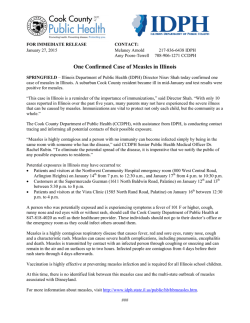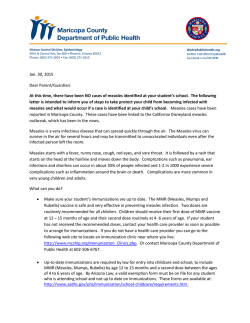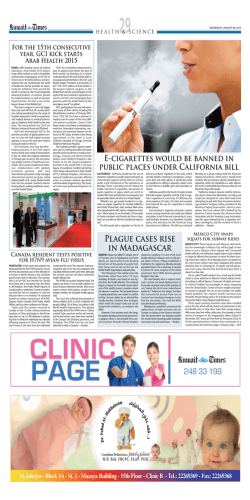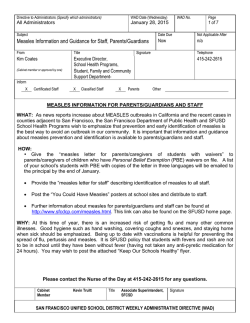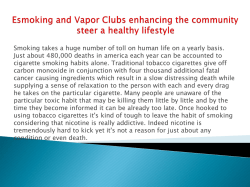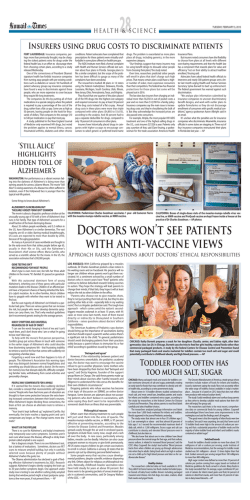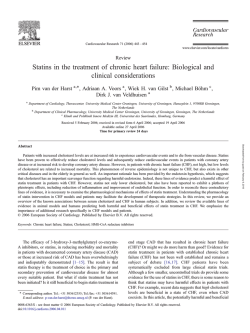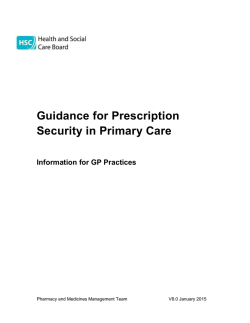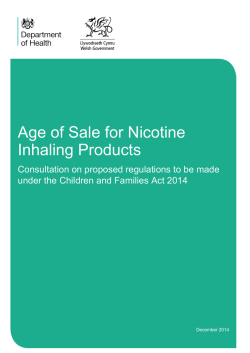
Page 36 Health 30/1/2015 Addd
ARAB TIMES, SATURDAY, JANUARY 31, 2015 HEALTH 36 Health Young adults vape E-cigs safe & fun technology SAN FRANCISCO, Jan 30, (RTRS): Many young adults are enthusiastically “vaping” e-cigarettes, drawn by the nifty technology, tasty flavors and their own physical sense that the devices are doing them no harm, according to new research. The authors of the small study, which focused on young adults in New York City, say this segment of the vaping population needs more educaLing tion on the possible health effects of e-cigarettes, including the potential for becoming addicted to nicotine. A ban on flavors and on marketing tactics that are already prohibited for tobacco could help slow the uptake of e-cigarettes as well, the researchers conclude in the journal Tobacco Control. “I think my main concern is not so much that this product is going to end up being more toxic than cigarettes — because cigarettes are so toxic you almost can’t come up with a product that is worse — but young adults are still in a stage where they are initiating nicotine use,” Dr Pamela Ling, one of the study’s two authors, told Reuters Health. E-cigarettes have grown into a $5 billion global business in recent years, but research into their safety and how and why people use the devices has lagged. Most researchers agree that the nicotine-laced vapor delivered by e-cigarettes contains far fewer toxic chemicals and none of the tar in traditional cigarettes. Smokers It’s still unclear whether e-cigarettes help smokers to cut down or quit traditional cigarettes, but a growing number are using them to try. Some research suggests that using nicotine in any form could open a gateway to addiction that leads young people to take up tobacco. California’s chief public health officer issued a report Wednesday calling e-cigarettes a threat to public health and the state’s anti-tobacco efforts. Many e-cigarette studies have focused on smokers, generally older, some with a declared intent to quit using tobacco. Ling and her coauthor wanted to look at how younger people, who may or may not be smokers, are using e-cigarettes and why. The researchers point out in their report that e-cigarette use in the US is highest among young people, with about 14 percent of 18-24 year olds having tried “vaping” in 2013. In 2012 and 2013, Ling and her colleague recruited 87 men and women between the ages of 18 and 27 years old for a series of focus groups followed by indepth interviews with a smaller group. About a third of participants had used an e-cigarette in the past 30 days. Just over half of those were daily smokers of tobacco and 41 percent smoked less than daily. Of the current e-cigarette users, 50 percent said they had no intention to quit smoking in the next six months, 48 percent said they had made a quit attempt in the past 12 months and 31 percent said they were currently trying to quit smoking. Pediatrician Charles Goodman poses for photo with the MMR vaccine, an immunization vaccine against measles, mumps, and rubella at his practice in Northridge, Calif, on Jan 29. With California gripped by a measles outbreak, Dr Goodman posted a clear notice on his door and on Facebook: His practice will no longer see children whose parents won’t get them vaccinated. At left, is his wife, Judith. (AP) Some doctors won’t see patients with anti-vaccine views With California gripped by a measles outbreak, Dr Charles Goodman posted a clear notice in his waiting room and on Facebook: His practice will no longer see children whose parents won’t get them vaccinated. It’s a sentiment echoed by a small number of doctors who in recent years have “fired” patients who continue to believe debunked research linking vaccines to autism. They hope the strategy will lead parents to change their minds; if that fails, they hope it will at least reduce the risk to other children in the office. “Parents who choose not to give measles shots, they’re not just putting their kids at risk, but they’re also putting other kids at risk — especially kids in my waiting room,” the Los Angeles pediatrician said. The tough-love approach — which comes amid the nation’s secondbiggest measles outbreak in at least 15 years, with 95 cases or more since last month, most of them traced directly or indirectly to Disneyland in Southern California — raises questions about doctors’ ethical responsibilities. The American Academy of Pediatrics says doctors should bring up the importance of vaccinations during visits but should respect a parent’s wishes unless there’s a significant risk to the child. “In general, pediatricians should avoid discharging patients from their practices solely because a parent refuses to immunize his or her child,” according to guidelines issued by the group. However, if the relationship between patient and doctor becomes unworkable, the pediatrics academy says, the doctor may want to encourage the vaccine refuser to go to another physician. Some mothers who have been dropped by their doctors feel “betrayed and upset,” said Dotty Hagmier, founder of the support group Moms in Charge. She said these parents made up their minds about vaccines after “careful research and diligence to understand the risks versus the benefits for their own children’s circumstances.” Dropping patients who refuse vaccines has become a hot topic of discus- sion on SERMO, an online doctor hangout. Some doctors are adamant about not accepting patients who don’t believe in vaccinations, with some saying they don’t want to be responsible for someone’s death from an illness that was preventable. Others warn that refusing treatment to such people will just send them into the arms of quacks. The measles-mumps-rubella vaccine, or MMR, is 97 percent effective at preventing measles, according to the Centers for Disease Control and Prevention. Measles spreads easily through the air and in enclosed spaces. Symptoms include fever, runny nose, cough and a rash all over the body. In rare cases, particularly among babies, measles can be deadly. Infection can also cause pregnant women to miscarry or give birth prematurely. All US states require children to get certain vaccinations to enroll in school. California is among 20 states that let parents opt out by obtaining personal belief waivers. Some people worry that vaccines cause developmental problems, despite scientific evidence disproving any link. Others object for religious or philosophical reasons. Nationally, childhood measles vaccination rates have held steady for years at above 90 percent. But there seem to be growing pockets of unvaccinated people in scattered communities, said Dr Gregory Wallace of the CDC. (AP) ‘High intensity therapy proven to be better’ After heart attacks, most don’t get enough statins NEW YORK, Jan 30, (RTRS): In the US, less than a third of older heart “event” patients being discharged from the hospital get the recommended high-intensity statins, according to a new study that looked at prescriptions filled. National guidelines from the American College of Cardiology and American Heart Association say the majority of patients should be on a high-dose statin following a serious heart disease-related event like heart attack or bypass surgery. “It appears that there’s tremendous reticence in prescription of statin therapy,” said lead author Dr Robert S. Rosenson of the Icahn School of Medicine at Mount Sinai in New York. “Whatever the dose of statin people were taking when they came to the hospital was the dose they went out on, the acute event didn’t change it,” he told Reuters Health. “This is very disappointing.” The authors studied a random sample of Medicare beneficiaries ages 65 to 74 who filled a statin prescription after having a heart attack or bypass surgery between 2007 and 2009. Of more than 8,000 people who filled a statin prescription after one of these events, only 27 percent of the first post-discharge prescriptions were for “high-intensity” statins, such as 40 to 80 milligrams of atorvastatin (Lipitor) or 80 milligrams of simvastatin (Zocor). Less than 25 percent of people who were not taking a statin before their hospitalization filled a high-intensity statin prescription on their release, and less than 10 percent of those who had been taking a low-intensity statin switched to a high-intensity one. Prescription About 80 percent of people who had already been taking high-intensity statins filled another such prescription immediately upon leaving the hospital, according to the results in the Journal of the American College of Cardiology. Of the patients whose first post-discharge prescription fill was for a low- intensity statin, less than 12 percent switched to a high-intensity dosage within the following year. “There’s a tremendous amount of confusion,” Rosenson said. Though the clinical guidelines, which are supported by rigorous studies and high quality results, indicate that high dose statins are better than low dose statins after an acute cardiac event, many doctors appear not to be following them. High intensity statins have been linked to better health outcomes in the short and long term for these patients, he said. “It could be that either the doctors are not aware of the guidelines that high intensity therapy is proven to be better, or more likely they are focusing on the (low-density lipoprotein) cholesterol level,” he said. There has been confusion on whether or not to dose statins based on LDL cholesterol readings for some patients, but for those who have suffered an acute cardiac event, a high dose is better, he said. “If statins are fairly safe and highly effective agents particularly for these types of patients, yet only about 50 to 60 percent of these patients are on what has been recommended and proved, why is that?” asked Dr Prakash Deedwania of the University of California San Francisco School of Medicine in Fresno who wrote an editorial accompanying the new results. Side effects from statins are rare, he noted, and cost of the drugs — which are mostly generic, inexpensive, and covered by insurance including Medicare — should not be an issue. There is some risk of developing what is know as “chemical diabetes,” but the benefits of the drugs far outweigh this risk, Deedwania told Reuters Health. Harm “The benefit is 10-fold greater than any sort of harm,” he said. When doctors know that an oversight body is going to be looking at their prescribing data, they are more likely to follow guidelines, he said. “We should be doing this without anyone looking, but unfortunately it doesn’t work like that,” Deedwania said. Though the authors focus on doctors likely not prescribing the recommended statin dose, there could be confusion or reluctance on the patient side as well, he said. Much like blood pressure medication, statins don’t provide immediate symptom relief while they are acting in the body. Since patients don’t feel a difference when they take the medication, they may not be motivated to continue taking it, he said. “The burden is on us to educate our patients, tell them precisely in simple terms what are the benefits of statins,” Deedwania said. In addition to reducing the risk of another heart attack and making a bypass graft more durable over time, statins reduce the risk of stroke, he said. “That resonates really well,” Deedwania said. “Everybody wants to get extra benefits,”
© Copyright 2025
